WEST BENGAL CO-OPERATIVE SERVICE COMMISSION
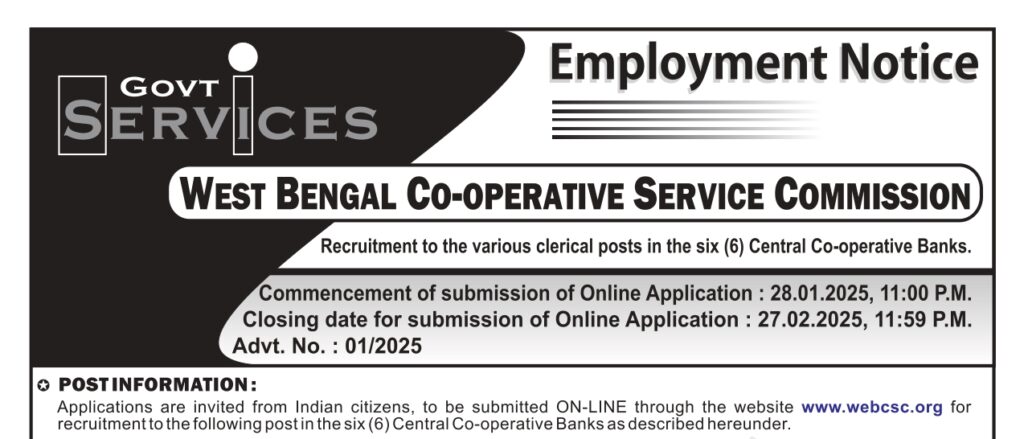
Recruitment in Central Co-operative Banks conducted by the West Bengal Co-operative Service Commission Recruitment to the various clerical posts in the six (6) Central Co-operative Banks conducted by the West Bengal Co-operative Service Commission. Commencement of submission of Online Application: 28.01.2025, 11:00 P.M. Closing date for submission of Online Application: 27.02.2025, 11:59 P..M. Advt. No. : 01/2025 POST INFORMATION: Applications are invited from Indian citizens, to be submitted online through the website www.webcsc.org for recruitment to the following post in the six (6) Central Co-operative Banks. As per the requirements of those Institutions, the candidates must have proficiency in reading, writing, and speaking Bengali to appear for the examination. N.B: Selection of OBC (B) category candidates shall abide by the final result and outcome of the Special Leave petition pending before the Hon’ble Apex Court SELECTION PROCEDURE: Tota l marks of 100 in the examination will be as follows, upon which the final merit list will be prepared: On-line CBT: Full Marks-85 Interview: FullMarks-15. 1. Stage-1: Candidates will have to appear for an ONLINE EXAMINATION named On-Line CBT (Computer Based Test), which will consist of85 a number MCQ type questions comprising of five subjects namely- There will be a negative marking mark against each incorrect answer. Full Marks: 85; Duration-2 hours. Stage I: Candidates will be called for a Descriptive Written Test (DWT) in a ratio of 1:10. On marks obtained in online CBT (Computer Test) and for Interview/ Viva-voce in a ratio of 1:6 based on the performance in the DWT. 2. Stage ll: Candidates will have to appear for the Descriptive Written Test (DWT) (Full Marks 50 and qualifying in nature). As per the merit list prepared based on the result of the CBT and have to secure 30% marks in the Descriptive Written Test (i.e. 15 or above) to be considered for the next stage of the interview. The marks obtained in the Descriptive Written Test will not be reckoned for preparing the final merit list after the interview. 3. Stage lll: The candidates from the CBT merit list; numbering 10 times vacant posts as per their order of merit in the CBT Merit List or the total number ofthe candidates in the CBT merit list, whichever is lower, will be called for the Descriptive Written Test for total marks of 50. The candidates who will not be able to secure 30% marks on 50 i.e. 15, will be disqualified for the interview. From the merit list of the rest of the passed candidates in the Descriptive Written Test, candidates numbering 6 times the vacant posts as per their order of merit in the Descriptive Written Test Merit List or the total number of the rest of the passed candidates in the Descriptive Written Test Merit List whichever is lower will be called for an interview APPLY NOW
Employment Notice by Railway Recruitment Board
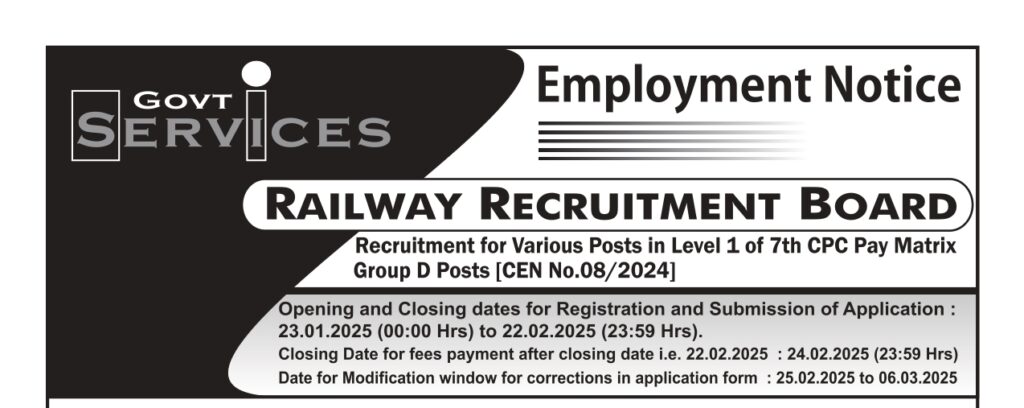
Employment Notice by Railway Recruitment Board for Various Posts in Level 1 of 7th CPC Pay Matrix Group D Employment Notice by Railway Recruitment Board for Various Posts in Level 1 of 7th CPC Pay Matrix Group D Posts [CEN No.08/2024). Opening and Closing dates for Registration and Submission of Application: 23.01.2025 (00:00 Hrs) to 22.02.2025 (23:59 Hrs). Closing Date for fee payment after closing date i.e. 22.02.2025 : 24.02.2025 (23:59 Hrs) Date for Modification window for corrections in an application form: 25.02.2025 to 06.03.2025 POST DETAILS AT A GLANCE: The summary of various posts is furnished below for reference. Further, the parameters (Qualification, Medical standard, and Suitability of the post for PwBD, etc.) of various posts included in the CEN are in AnnexureA and the Railway and post-wise vacancy for all the notified posts is in Annexure B. However, the Railway reserves the right to revise these vacancies in part or full 0 ESSENTIAL EDUCATIONAL QUALIFICATIONS: Diploma I Degree in Engineering will not be accepted instead of Course Completed Act Apprentices/ITl for the post of Level-1 unless otherwise specified. Graduate Act Apprentice will not be accepted in place of Course Completed Act Apprenticeship(CCAA)… Candidates should have passed 10th (Matriculation) or ITI or equivalent or National Apprenticeship Certificate (NAC) granted by NCVT as on the closing date for ONLINE Registration. Those awaiting results of their final examination of the prescribed minimum educational/technical qualification SHOULD NOT apply. Modes of Payment of Fee : Closing Date and Time of Fee Payment: Online payment will be allowed till 23.59 hrs. of 24.02.2025, for candidates who register successfully till 23:59 hrs. of 22.02.2025. inclusion, if any, received till the closing date for ONLINE registration of application for this CEN. The examination fee paid by the candidates whose application is incomplete or those who have not submitted their application or whose application is rejected, will not be refunded HOW TO APPLY: More details: + Candidate Photograph (against a plain white background): JPEG image of size 50 KB to 100 KB. + Candidate Signature: JPEG image of size 30 KB to 50 KB. + Scribe Photo(wherever applicable) : JPEG image of size 50 KB to 100 KB. For more details please go through the original notification Application link: www.rrbkolkata .gov.in or https://www.rrbapply.gov.in/ APPLY NOW
RECRUITMENT OF JUNIOR ASSOCIATES (CUSTOMER SUPPORT & SALES)
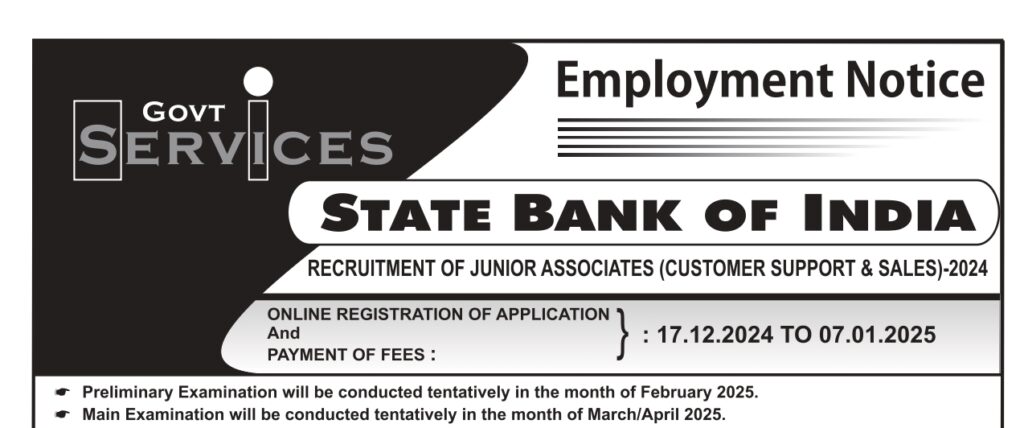
RECRUITMENT OF JUNIOR ASSOCIATES RECRUITMENT OF JUNIOR ASSOCIATES (CUSTOMER SUPPORT & SALES) for State Bank of India ONLINE REGISTRATION OF APPLICATION } And PAYMENT OF FEES : 17.12.2024 TO 07.01.2025 A preliminary Examination will be conducted tentatively in February 2025. The main Examination will be conducted tentatively in March / April 2025. AGE (As of 01.04.2024): Not below 20 years and not above 28 years as of 01.04.2024,i.e. candidates must have been born not earlier than 02.04.1996 and not later than 01.04.2004 (both days inclusive). > Relaxation of upper age limit: SC/ ST – 5 years, OBC – 3 years, and others as per rules. ESSENTIAL ACADEMIC QUALIFICATIONS (As of 31.12.2024): Graduation in any discipline from a recognized University or any equivalent qualification recognized as such by the Central Government. Candidates having integrated dual degree (IDD) certificates should ensure that the date of passing the IDD is on or before 31.12.2024. > Those who are in the final year/ semester of their graduation may also apply provisionally subject to the condition that, if provisionally selected, they will have to produce proof of having passed the graduation examination on or before 31.12.2024. HOW TO APPLY: Candidates can apply online and no other mode of application will be accepted. Candidates will be required to register themselves online through the Bank’s website https://bank .sbi/web/careers/current-openings OR https://www.sbi.eo.in/web/careers/current-openings-Recruitment of Junior Associates 2024… After registration candidates are required to pay the requisite application fee through online mode by using debit card/ credit card/ Internet Banking. Helpdesk: In case of any problem in filling up the form, payment of feel intimation charges, or receipt of Admission/call letter, queries may be made at telephone no. 022-22820427 (between 11:00 AM and 05:00 PM on working days) or lodge his/her query on http://cgrs.ibps.in. Candidates are advised not to forget to mention ‘Recruitment of Junior Associate-2024’ in the subject of the email. Pre-requisites for Applying Online: kept active in the declaration of results. It will help him/ her in getting call letters/pieces of advice etc. by email/ SMS. b. The text of the hand-written declarations is as follows: “I, (Name of the candidate), Date of Birth … hereby declare that all the information submitted by me in the application form is correct, true, and valid. I will present the supporting documents as and when required. The signature, photograph,h and left thumb impression is of mine”. c. Left Thumb Impression: If a candidate does not have a left thumb, they may use his /her right thumb for applying) d. Candidates to visit the Bank’s web site https://bank.sb i/careers/ Current- openings or https://www.sbi.co.in/careers/Current-openi ngs and open the appropriate Online Application Form, available under Recruitment of JuniorAssociates. Apply g. Fee can be paid by using debit card/ credit card/ Internet Banking by providing information as asked on the screen. Transaction charges for online payment, if any, will be borne by the candidates.
RECRUITMENT OF PROBATIONARY OFFICERS (POs)-2024
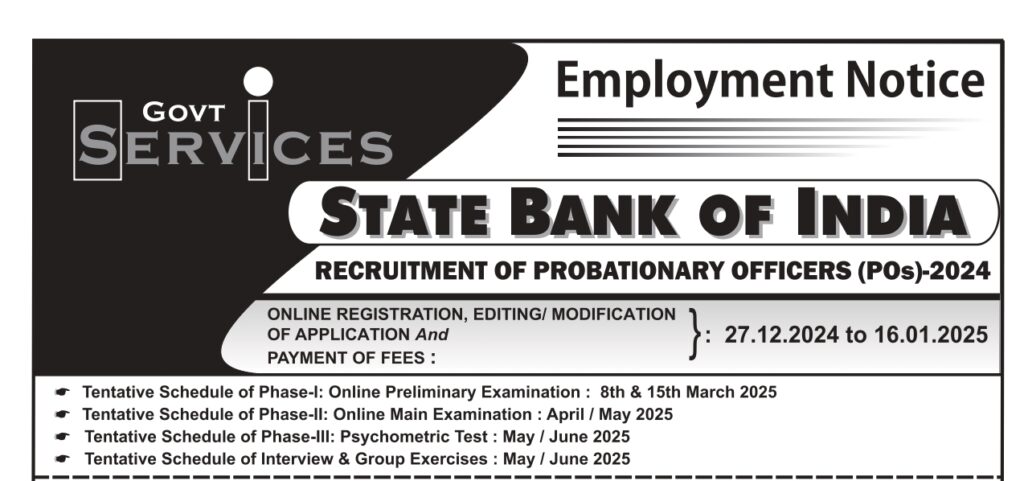
RECRUITMENT OF PROBATIONARY OFFICERS (POs)-2024 RECRUITMENT OF PROBATIONARY OFFICERS (POs)-2024 by STATE BANK OF INDIA ONLINE REGISTRATION, EDITING/ MODIFICATION } OF APPLICATION AND PAYMENT OF FEES: 27.12.2024 to 16.01.2025 AGE (As of 01.04.2024): Not below 21yearsandnot above 30 years as of 01.04.2024 i.e.candidates must have been born not later than 01.04.2003 and not earlier than 02.04.1994 (both days inclusive). Relaxation in the Upper age limit shall be as follows: Relaxation of Upper age limit: SC/ ST – 5 years, OBC – 3 years, Others as per rules. ESSENTIAL ACADEMIC QUALIFICATIONS (As of 30.04.2025): Graduation in any discipline from a recognized University or any equivalent qualification recognized as such by the Central Government. > Those who are in the Final Year/ Semester of their Graduation may also apply provisionally subject to the condition that, if called for interview, they will have to produce proof of having passed the graduation examination on or before 30.04.2025. Candidates having an Integrated Dual Degree (IDD) certificate should ensure that the date of passing the IDD is on or before 30.04.2025. Candidates possessing qualifications such as Medical, Engineering1, Chartered Accountant, Cost Accountant, etc. would also be eligible. > Candidate should indicate the percentage obtained in Graduation calculated to the nearest two decimals in the online application. Where CGPA/ OGPA is awarded, the same should be converted into a percentage and indicated in the online application. If called for an interview, the candidate will have to produce a certificate issued by the appropriate authority inter alia stating the norms of the University. Regarding the conversion of grades into percentages and the percentage of marks scored by the candidate in terms of these norms. > Calculation of Percentage: The percentage marks shall be arrived at by dividing the total marks obtained by the candidate in all the subjects in all the semester(s)/ year(s) by aggregate maximum marks in all the subjects irrespective of Honours/ optional/additional optional subject, if any. This will be applicable for those Universities where Class/ Grade is decided based on Honours marks only. The fraction of percentage so arrived will be ignored i.e. 59.99% will be treated as less than 60% and 54.99% will be treated as less than 55%. HOW TO APPLY: Candidates can apply online only from 27.12.2024 to 16.01.2025. No other mode of application will be accepted. Candidates will be required to register themselves online through the Bank’s ‘Career’ website https://bank.sbi/careers or https://www.sbi.co.in/careers. After registration candidates are required to pay the requisite application fee. Through online mode by using debit card/ credit card/ Internet Banking. … Helpdesk: In case of any problem in filling up the form, payment of fee/ intimation charges, or receipt of Admission / call letter. Do queries may be made at telephone no. 022-22820427 (between 11:00 AM to 06:00 PM on working days). Or lodge their query at http://cgrs.ibps.in. Candidates should mention ‘RECRUITMENT OF PROBATIONARY OFFICERS IN STATE BANK OF INDIA-2024’ in the subject of the email.
Recruitment in NTPC by Railway Recruitment Board
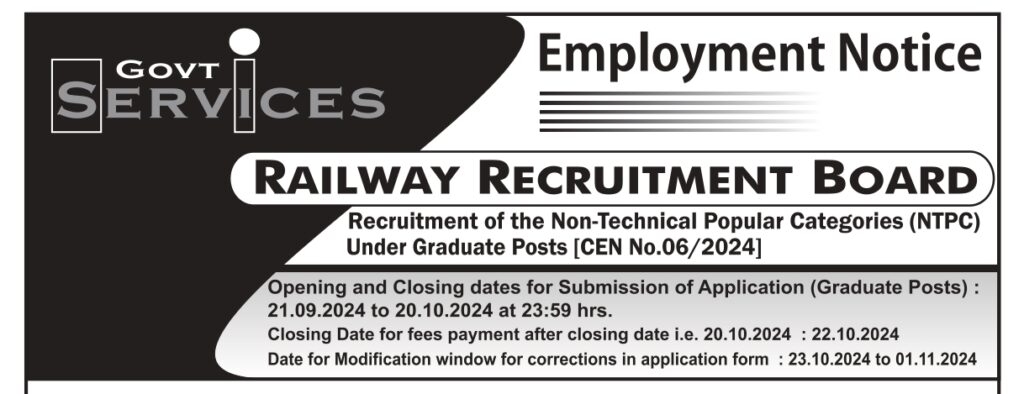
Recruitment in NTPC by Railway Recruitment in NTPC By Railway – Non-Technical Popular Categories (NTPC) Under Graduate Posts [CEN No.06/2024] Opening and Closing dates for Submission of Application (Graduate Posts): 21.09.2024 to 20.10.2024 at 23:59 hrs. Closing Date for fee payment after closing date i.e.20.10.2024:22.10.2024 Date for Modification window for corrections in application form: 23.10.2024 to 01.11.2024 POST DETAILS AT A GLANCE: Applications are invited from eligible candidates for the following posts of Non-Technical Popular Categories in the table(s) below. Application(s) (complete in all respects) must be submitted ONLINE ONLY. For details, please refer to CEN No.06/2024(Under Graduate) listed on the official websites of RRBs. Under Graduate Posts with Minimum Educational Qualification of 12th (+2 Stage) or its equivalent examination and Age between 18 to 33*Years (with 3 years relaxation as per detailinCEN) as of 01.01.2025. ESSENTIAL EDUCATIONAL QUALIFICATIONS: Modes of Payment of Fee : Closing Date and Time of Fee Payment: Online payment will be allowed till 23.59 hrs. of 22.10.2024, for candidates who register successfully till 23:59 hrs. of 20.10.2024. After making payment, these candidates should submit their applications on or before 23:59 hrs. of 20.10.2024. HOW TO APPLY for Recruitment in NTPC by Railway: + Candidate Photograph: JPEG image of size 30 KBto 70 KB + Candidate Signature: JPEG image of size 30 KBto 70 KB + SC/ST Certificate (Only for candidates seeking Free TravelPass): PDF format of size up to 500 KB. + Scribe Photo(wherever applicable): JPEG image of size 30 KBto 70 KB e Once the RRB has been selected, preliminary registration is completed. Once the registration number is allotted, a change of RRB will not be permitted under any circumstances. Moreover, candidates are required to go to the link provided for filling ONLINE application. Fill up the personal details/Bio Data, fee paid, etc. carefully. They are also required to exercise their option/preference for Post(s), Railway(s)/Production Unit(s).
Rainfall in India

Rainfall in India by Saugata Singha Mr. Saugata Singha has been associated with MIES Institute for the last 15 years as a guest faculty. He has a lot of experience teaching WBCS, SSC, PSC, RAIL, etc exams. So here is an honest trial from his end to provide this awesome piece of writeup on Rainfall in India. He is very grateful to MIES Management for giving him a chance as a guest faculty to MIES Institute which is one of the best competitive coaching centers in West Bengal. In his opinion, MIES Institute is one of the top competitive exam institutes in West Bengal. MIES is a renowned coaching center for Govt. Job exams in West Bengal. Thousands of students appeared in Govt. service exam from MIES every year and got Govt. service maximum of them. MIES is the most popular institute among Govt. Job aspirants because of their specialty in School Service, WBCS, PSC, SSC, BANK, RAIL, etc exams. MIES is a pioneer institute of West Bengal Civil Service coaching in West Bengal. As per the student’s version, MIES is the Best Training Academy for Govt. Job exam in West Bengal. Rainfall in India India experiences diverse climatic conditions, and its rainfall pattern is influenced by the monsoon winds. The Indian subcontinent primarily witnesses two main types of rainfall: the Southwest Monsoon and the Northeast Monsoon. Southwest Monsoon: Timing: The Southwest Monsoon is the most significant rainfall period for India and typically occurs from June to September. Direction: Moisture-laden winds from the Indian Ocean move towards the Indian subcontinent, bringing heavy rainfall. Regions Affected: The Western Ghats, the Himalayan foothills, and the northeastern states receive substantial rainfall during this monsoon. The Indo-Gangetic plain and the Deccan Plateau also get a significant amount of rain. Northeast Monsoon’s Timing: The Northeast Monsoon occurs from October to December, mainly affecting the southern and southeastern parts of India. Direction: During this period, the winds reverse, and moisture-laden winds move from the Bay of Bengal towards the land. Regions Affected: Mainly in Tamil Nadu (Maximum Rainfall) Andhra Pradesh, Karnataka, and parts of northeastern India receive rainfall during the Northeast Monsoon. Distribution of Rainfall: The amount of rainfall varies across different regions of India. The western coast, especially the Western Ghats, receives heavy rainfall due to orographic features. The eastern coast, particularly during the Northeast Monsoon, also experiences considerable rainfall. The northwestern parts, such as Rajasthan, are arid and receive minimal rainfall. Monsoon Variability: Monsoon rains are crucial for agriculture in India, as a significant portion of the country relies on rainfed agriculture. Variability in monsoon patterns can impact agricultural output and the overall economy. Monsoon Forecasting: The India Meteorological Department (IMD) plays a crucial role in forecasting and monitoring the monsoon. They release seasonal forecasts that are vital for agricultural planning and water resource management. Monsoon Challenges: In some years, there may be instances of excess or deficient rainfall, leading to floods or droughts, respectively. Climate change is also influencing monsoon patterns, contributing to increased variability and uncertainties. Understanding the rainfall patterns is essential for various sectors in India, including agriculture, water resource management, and disaster preparedness. The timely and adequate distribution of rainfall is critical for sustaining the country’s diverse ecosystems and supporting its agricultural practices. The Southwest Monsoon is a crucial weather phenomenon for India, bringing the majority of the country’s annual rainfall. It is a seasonal wind pattern characterized by the reversal of wind direction, bringing moisture-laden air from the Indian Ocean to the Indian subcontinent. Here are key aspects of the Southwest Monsoon in India: Wind Reversal: During the Southwest Monsoon, the prevailing wind direction over the Indian subcontinent reverses. The normal wind direction is from land to sea, but during the monsoon, moist air from the southwest (Indian Ocean) replaces the dry air over the Indian subcontinent. Rainfall Distribution: The Western Ghats, the Himalayan foothills, and northeastern India receive the heaviest rainfall during the Southwest Monsoon. The monsoon winds hit the Western Ghats first, leading to orographic rainfall on the windward side (west), creating lush landscapes and supporting biodiversity. The rain shadow effect occurs on the leeward side (east) of the Western Ghats, resulting in drier conditions in certain regions. Agricultural Importance: The Southwest Monsoon is crucial for Indian agriculture, as a significant portion of the country’s farmland relies on rainfed cultivation. Timely and adequate monsoon rainfall is essential for a successful sowing and cropping season. Monsoon Variability: Monsoon rainfall can vary from year to year, impacting agricultural productivity. Years with deficient rainfall may lead to drought conditions, affecting crops and water resources. Economic Impact: The Southwest Monsoon has a significant impact on the Indian economy, influencing agricultural output, food production, and overall economic well-being. Monsoon Retreat: The withdrawal of the Southwest Monsoon begins around September, starting from the northwestern parts of India and gradually moving towards the southeast. Understanding the Southwest Monsoon is essential for farmers, policymakers, and various sectors in India. The monsoon’s dynamics significantly influence water availability, agricultural practices, and the overall socioeconomic conditions of the country. The Northeast Monsoon, also known as the winter monsoon or the post-monsoon season, is a seasonal wind pattern that brings rainfall to parts of India during the winter months. It is a regional reversal of wind direction, and it mainly affects the southern and southeastern regions(Tamil Nadu) of India. Here are some key points about the Northeast Monsoon in India: Direction of Winds: During the Northeast Monsoon, the winds reverse their direction, moving from land to sea. Moisture-laden winds from the Bay of Bengal and the northeastern part of the Indian Ocean move towards the eastern coast of India. Regions Affected due to Rainfall in India: The primary areas affected by the Northeast Monsoon in India include the southeastern coast, parts of the eastern coast, and some inland areas. States such as Tamil Nadu, Andhra Pradesh, Karnataka, and parts of Telangana receive a significant amount of rainfall during this monsoon. Rainfall Pattern: The rainfall during the Northeast Monsoon
COMBINED HIGHER SECONDARY LEVEL EXAMINATION 2024
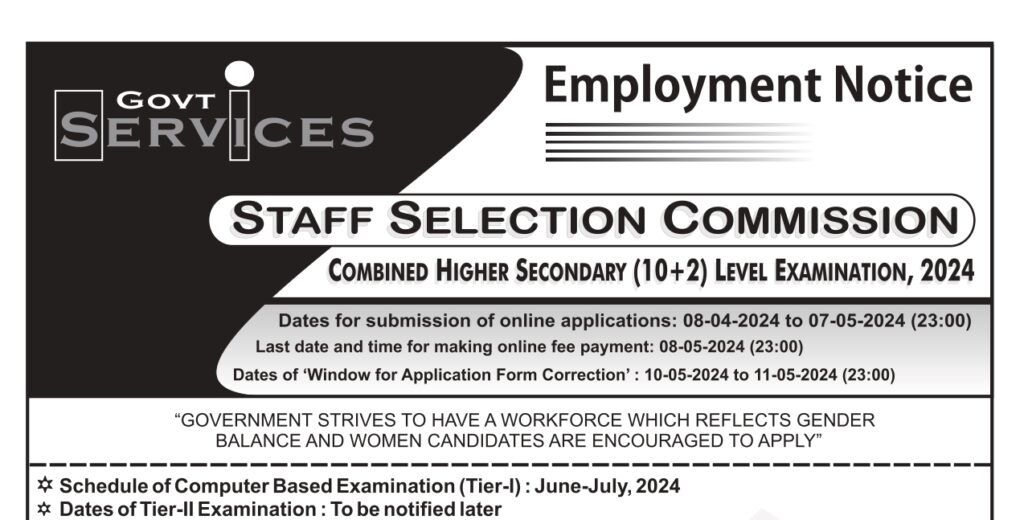
COMBINED HIGHER SECONDARY LEVEL EXAMINATION 2024 by Staff Selection Commission COMBINED HIGHER SECONDARY LEVEL EXAMINATION 2024 (10+2) by Staff Selection Commission. The Staff Selection Commission will hold a competitive examination for recruitment to the Group C posts viz. Lower Divisional Clerk/ Junior Secretariat Assistant and Data Entry Operators for various Ministries/Departments/ Offices of the Government of India and various Constitutional Bodies/Statutory Bodies/Tribunals, etc.. GOVERNMENT STRIVES TO HAVE A WORKFORCE WHICH REFLECTS GENDER BALANCE AND WOMEN CANDIDATES ARE ENCOURAGED TO APPLY” *Schedule of Computer Based Examination (Tier-I) :June-July, 2024Dates of Tier-II Examination :To be notified later AGE LIMIT (As on 01-08-2024): The Age limit for the posts is 18-27 years i.e. Candidates born not before 02-08-1997 and not later than 01-08-2006 are eligible to apply. ESSENTIAL EDUCATIONAL QUALIFICATIONS (As of 01-08-2024): APPLICATION FEE: IMPORTANT INSTRUCTIONS TO CANDIDATES BEFORE APPLYING, CANDIDATES MUST GO THROUGH THE INSTRUCTIONS GIVEN IN THE NOTICE OF EXAMINATION VERY CAREFULLY. THE NOTICE OF EXAMINATION IS PRINTED BOTH IN ENGLISH AND HINDI. IN CASE OF ANY DISPUTE, THE ENGLISH VERSION WILL PREVAIL. ***For any details please go through the original notification.**** Application link: https://ssc.go.in
RECRUITMENT TO THE POST OF CONSTABLE

RECRUITMENT TO THE POST OF CONSTABLES IN WEST BENGAL POLICE • 2024 COMMENCEMENT OF SUBMISSION OF ONLINE APPLICATION: 07.03.2024 (from 00:01 hrs.) LAST DATE OF RECEIPT OF ONLINE APPLICATION: 05.04.2024 (till 23:59 hrs.). Editing Window :·08.04.2024 to 14.04.2024 EDUCATIONAL QUALIFICATION : The applicant must have passed the Madhyamik Examination from the West Bengal Board of Secondary Education or its equivalent AGE (As of 01/01/2024): 18-30 Years (Relaxation of age limit for SC/ST – 5 Years, OBC – 3 Years, Third Gender! transgender persons – 3 Years, Civic Volunteers I Village Police Volunteers. – 5 Years). The upper age limit is also relaxable for NVF/Home Guards Personnel serving in WestBengal Police only as per existing Government Rules LANGUAGE: – The applicant must be able to read, write, and speak Bengali language provided that the provision will not apply to the persons who are permanent residents of hill sub-divisions of Darjeeling and Kalimpong Districts. Note:- Applicants already employed in any Government Organization shall produce no Objection Certificate (NOC) from the Head of the Office/Disciplinary authority during the interview, if shortlisted for the same EDITING WINDOW :- An editing window for 07 (seven) days will be given to the applicants who want to edit/rectify their personal information already submitted in their Application Form. The period of this editing window will be available from 08.04.2024 to 14.04.2024. To edit the personal information, the applicant will have to provide their (i) Application SL No. or Registered Mobile Number (ii) Date of Birth (DOB) as entered in the Application. On providing these information, the applicant will get an OTP to their Mobile Number. On successful verification of OTP the applicant will be allowed to edit their information (except permanent State, Mobile Number & E-mail Id.). Applicants can change their category but change from non-paying category (SC &ST) to paying category (UR, EWS, OBC-A & OBC-B) [Application Fees) shall not be allowed. After editing all the details, the applicant has to submit the edited application otherwise no change will be reflected in the main data. Applicants will also be able to download the modified application pdf only after submission of the edited application or else the previous application pdf will be available. Request for change/correction in the personal details (except category) shall not be entertained under any circumstances after the last date of editing window. The West Bengal Police Recruitment Board will not be responsible for any consequences arising out of non-acceptance of any correction/addition/deletion in any particular field in application form whatever the reason may be. However, if a candidate procures caste certificate after editing window is closed and wants to change his/her category, the candidates must submit the petitions with relevant documents at changing caste.category ews.only@gmail.com mentioning the subject properly with Application SI. No. and Recruitment Drive e.g. “Sub.: Change of Caste/Category, Appl. SI. No. XXXXXXXX , Constables in West Bengal Police – 2024″ THE APPLICANTS ARE STRONGLY ADVISED TO SUBMIT THEIR APPLICATIONS WELL IN ADVANCE WITHOUT WAITING FOR THE LAST DATE AND TIME OF SUBMISSION TO AVOID DELAYED SUBMISSION DUE TO SERVER PROBLEM OR ANY OTHER TECHNICAL GLITCHES.
Indian National Movement
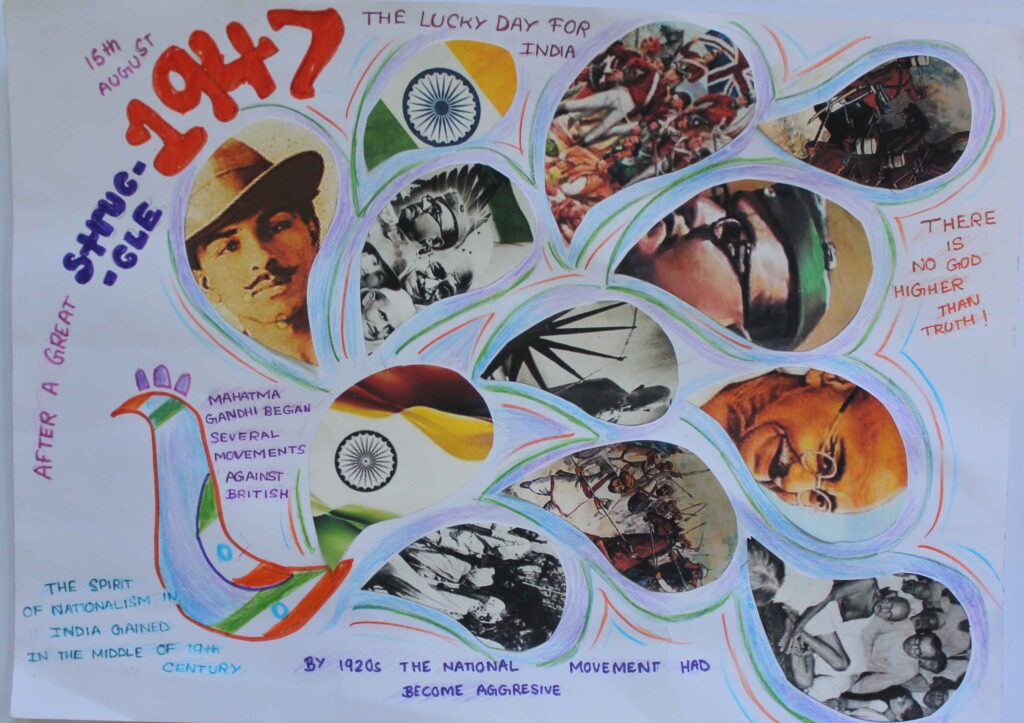
Indian National Movement Mr. Prodipta Chatterjee wrote this article in the Indian National Movement. He has been associated with MIES Institute for the last 15 years as a guest faculty. Has experience teaching WBCS, SSC, PSC, RAIL, etc exams. Moreover, he is very grateful to MIES Management for giving him a chance as a guest faculty to MIES Institute which is one of the best competitive coaching centres in West Bengal. In His opinion, MIES Institute is one of the top competitive exam institutes in West Bengal. Candidates preparing for the WBCS exam should focus on these key aspects. Concerning the Indian National Movement within the context of the history syllabus. The First War of Independence in India Often referred to as the Sepoy Mutiny or the Indian Rebellion of 1857, was a significant uprising against British rule. The rebellion took place between 1857 and 1858 and had widespread repercussions on the course of Indian history. Here are key aspects of the First War of Independence: Causes of Indian National Movement: 1. Military Grievances: The immediate cause was the introduction of the new Enfield rifle, whose cartridges were rumored to be greased with animal fat (cow and pig fat). This offended both Hindu and Muslim sepoys (Indian soldiers), as using such cartridges violated their religious beliefs. 2. Economic Exploitation: The economic policies of the British East India Company, which led to land revenue policies and the imposition of heavy taxes, created widespread agrarian discontent. 3. Social and Cultural Factors: There was a growing sense of resentment among the Indian soldiers and the civilian population due to perceived cultural and religious insensitivity by the British. 4. Annexation of Kingdoms: The annexation of various Indian states and the policy of annexation led to the displacement of many rulers and contributed to the discontent. 5. Sepoy Influence: The sepoys, who were an integral part of the British Indian Army, played a crucial role in the rebellion. Their discontent spread quickly, leading to a widespread uprising. Barrackpore Mutiny (1857): The rebellion began in Barrackpore when sepoys refused to use the controversial cartridges. Leading to a series of events that culminated in the outbreak of the larger rebellion. Siege of Delhi: Rebels captured Delhi in May 1857, and the last Mughal emperor, Bahadur Shah II, was proclaimed the leader of the rebellion. Repression: The British responded with a ruthless crackdown, leading to widespread arrests, executions, and reprisals against the rebels. End of the East India Company The British Crown took control of India from the East India Company in 1858, and the British government pursued a more direct and assertive rule. The First War of Independence marked a turning point in India’s history, leading to the end of the East India Company’s rule and the beginning of direct British governance in India. It also had a lasting impact on the Indian psyche and contributed to the subsequent nationalist movements against British colonial rule. The Moderate Phase of the Indian National Movement spanning roughly from 1885 to 1905 refers to the initial years of the Indian National Congress (INC) and the political approach adopted by its early leaders. The leaders during this phase were often labeled as “Moderates” due to their relatively moderate and constitutional methods of seeking political reforms within the framework of the British colonial administration. Early Leaders (Moderates): The early leaders of the INC during this phase were often referred to as Moderates. Some prominent leaders include DadabhaiNaoroji, WomeshChunderBonnerjee, DinshawWacha, DadabhaiNaoroji, and Gopal Krishna Gokhale. Aims and Objectives: The Moderates focused on constitutional methods, petitions, and resolutions to convey Indian grievances to the British authorities. They sought to create a platform for dialogue and cooperation between the British and Indians. Leaders like DadabhaiNaoroji presented economic critiques of British policies, emphasizing the economic drain from India to Britain and the need for economic self-sufficiency. Educational and Social Reforms: The Moderates also focused on educational and social reforms, aiming to promote modern education and social progress among Indians. Despite their efforts, the Moderates faced challenges, as the British government was often unwilling to grant significant concessions. The lack of mass support and the limited impact of their methods became apparent. The Indian National Congress (INC) Was founded in 1885 and played a crucial role in the Indian independence movement. The formation of the INC marked a significant development in the political landscape of British India The first session of the Indian National Congress was held from December 28 to December 31, 1885, at GokuldasTejpal Sanskrit College in Bombay (now Mumbai). The session was attended by 72 delegates from different parts of the country, representing different communities and interests. The INC aimed to obtain a greater share in government for educated Indians. The early demands were focused on constitutional reforms, representation, and civil rights for Indians within the British colonial framework. The INC gradually transformed into a symbol of the Indian nationalist movement. As the struggle for independence intensified, the INC became the principal political party representing the aspirations of a united India. The foundation of the Indian National Congress marked the beginning of organized political activity in India against British rule. Over the years, the INC played a central role in shaping India’s destiny, eventually leading the country to independence in 1947. The Partition of Bengal 1905 was a controversial administrative reorganization carried out by the British colonial authorities in India. The decision sparked widespread protests and had significant political and social implications. Here are the key details surrounding the Partition of Bengal. Administrative Reasons: The British claimed that the partition was driven by administrative efficiency. Bengal, at the time, was one of the largest provinces in British India, and the authorities argued that dividing it would make administration more manageable. Date: The formal announcement of the partition was made on July 19, 1905, and it took effect on October 16, 1905. Territorial Changes: Bengal was divided into two separate entities – East Bengal and Assam, with a majority Muslim population, and the rest
